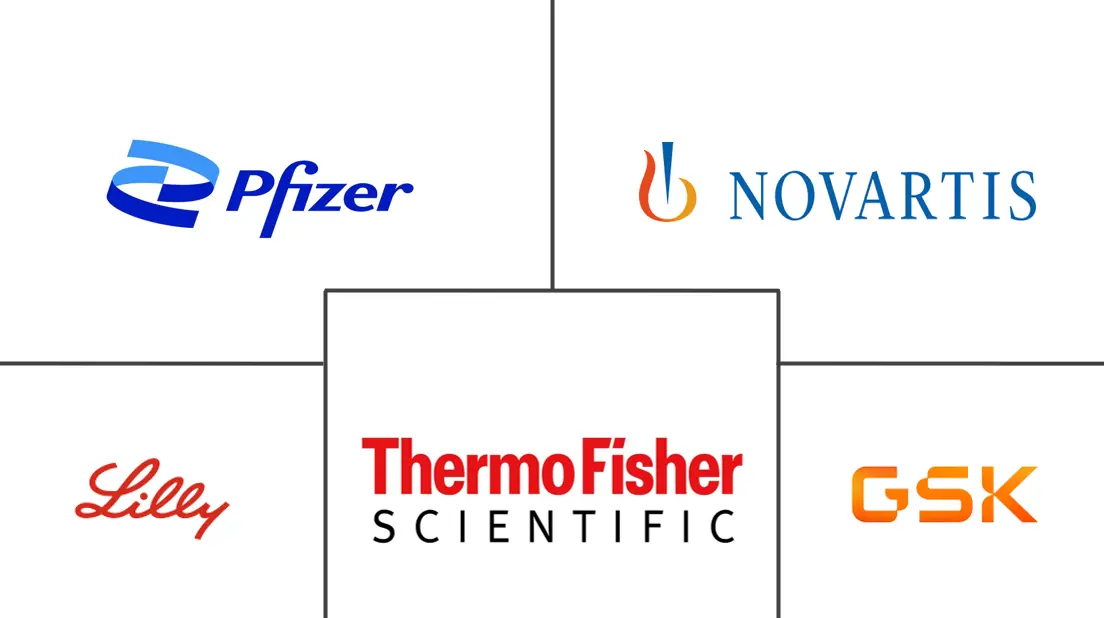Recombinant Protein Market Size and Share

Recombinant Protein Market Analysis by Mordor Intelligence
The Recombinant Protein Market size is estimated at USD 2.9 billion in 2025, and is expected to reach USD 4.25 billion by 2030, at a CAGR of 7.91% during the forecast period (2025-2030).
Rapid uptake of protein-based therapeutics, wider acceptance of precision medicine, and expansion into food and industrial biotechnology underpin this forward momentum. An additional catalyst is the convergence of artificial intelligence with protein engineering, which is shortening design-to-clinic timelines and widening product pipelines. Higher throughput discovery tools are gradually lowering entry barriers for midsized companies, shifting the industry toward a more distributed innovation model. Continued regulatory clarity around biosimilars and interchangeable products is expected to smooth commercial pathways and accelerate time-to-revenue for late-stage assets.
Despite this growth trajectory, structural headwinds persist. High capital intensity in mammalian cell culture, supply chain constraints for critical raw materials, and price erosion triggered by biosimilars weigh on margins, particularly for established blockbuster molecules. Currency fluctuations add complexity for producers with multi-regional manufacturing footprints, as the majority of production costs are denominated in USD while sales in emerging markets are booked in local currencies. Margin resilience will increasingly depend on operational agility, driving adoption of single-use technologies and continuous processing to optimize batch economics. As production platforms diversify, the Recombinant Proteins industry appears set to balance scientific innovation with cost efficiency in order to sustain long-term profitability.
Key Report Takeaways
- Asia-Pacific remains the fastest-growing geography at a 9.51% CAGR through 2030, supported by multibillion-dollar national bio-manufacturing programs in China and South Korea.
- Fusion proteins and bispecific antibodies register the highest product CAGR (8.43%), as their multi-functional designs streamline combination regimens and raise patient adherence.
- Cell-free expression systems post an 8.72 % CAGR, trimming development cycles from weeks to days and opening the Recombinant Proteins market to otherwise toxic or unstable sequences.
- Therapeutic applications hold 34.2 1% Recombinant Proteins market share in 2024; however, industrial uses such as precision-fermented food proteins are forecast to close the gap with a 9.26 % CAGR.
Global Recombinant Protein Market Trends and Insights
Driver Impact Analysis
| Driver | (~) % Impact on CAGR | Geographic Relevance | Impact Timeline |
|---|---|---|---|
| Technological advancements in recombinant products | +1.6 % | Global | Short term (≤ 2 years) |
| Growing burden of chronic diseases | +1.4 % | Global | Medium term (2-4 years) |
| Rising inclination toward biologics & biosimilars | +1.2 % | North America, Europe | Medium term (2-4 years) |
| Personalised recombinant enzymes for rare metabolic disorders (EU) | +0.7 % | Europe | Long term (≥ 4 years) |
| Personalised recombinant enzymes (global) | +0.9 % | Global | Long term (≥ 4 years) |
| Government biocluster funding | +1.0 % | US, EU, Asia-Pacific | Short term (≤ 2 years) |
| Source: Mordor Intelligence | |||
Technological Advancements Accelerate Protein Engineering Capabilities
Breakthroughs in deep-learning structure prediction and de novo design are enabling researchers to specify binding sites, stability, and activity with unprecedented precision. Laboratory evidence indicates that split-intein strategies prevent misfolding in complex constructs, generating higher active yields without lengthy re-folding steps [1]Christina Hoppenbrock, “Improved Method for Producing Designer Proteins Prevents Misfolding,” Phys.org, phys.org. The Recombinant Proteins industry is therefore seeing the design-to-production window contract from months to weeks, a shift that implicitly frees capacity for additional targets. In silico screening is emerging as a strategic differentiator on par with physical manufacturing capabilities.
Growing Burden of Chronic Diseases Drives Therapeutic Applications
Escalating incidence of oncology, autoimmune, and metabolic disorders is steering healthcare spending toward targeted biologics. More than one hundred monoclonal antibodies now hold regulatory approval, and recent FDA decisions reinforce confidence in protein-based modalities. Payers increasingly support earlier line use of biologics, reflecting their disease-modifying potential. Sustained clinical demand can offset competitive pricing pressures when products demonstrate clear health-economic value across the recombinant proteins market.
Rising Inclination Toward Biologics & Biosimilars Reshapes Market Dynamics
Expiry of first-generation biologic patents is fueling biosimilar launches, accelerating therapeutic access while compressing price ceilings. The FDA's proposal to retire the interchangeability designation removes an administrative hurdle and could bring development costs for follow-on molecules closer to small-molecule generics. As reference products lose exclusivity, manufacturers are redistributing R&D spend toward next-wave assets such as multispecific antibodies. Price erosion will increasingly be offset by lifecycle-management strategies and portfolio refreshes within the recombinant proteins market.
Personalized Recombinant Enzymes Address Rare Metabolic Disorders
Tailored enzyme replacement therapies (ERTs) now leverage modified glycosylation and sequence tuning to enhance tissue uptake while reducing immunogenicity. Peer-reviewed data on engineered β-glucocerebrosidase show up to six-fold activity gains in Gaucher disease models [2]Lucas Bleicher, “Engineering Synthetic and Recombinant Human Lysosomal β-Glucocerebrosidase for Enzyme Replacement Therapy for Gaucher Disease,” Discover Applied Sciences, springer.com . Higher potency enables lower dosing volumes, which, in turn, reduces infusion chair time and ancillary costs. Payers may tolerate premium list prices when overall treatment burden declines, reinforcing long-term value creation in the recombinant proteins market.
Government Biocluster Funding Accelerates Recombinant Biologics Capacity
The U.S. Department of Defense allocated USD 42 million to distributed biomanufacturing grants in 2024 to reinforce domestic supply lines. Parallel initiatives by the White House and the European Commission streamline permitting and workforce development, catalyzing build-outs of multi-tenant biocampuses. These clusters shorten supply chains and embed technology anchors near academic hubs, an arrangement that implicitly accelerates technology transfer from bench to plant. When speed and supply security are priorities, proximity advantages can outweigh lower overseas labor costs.
Restraint Impact Analysis
| Restraint | (~) % Impact on CAGR | Geographic Relevance | Impact Timeline |
|---|---|---|---|
| High production costs | -1.5 % | Global | Short term (≤ 2 years) |
| Price erosion and cold-chain gaps | -0.8 % | Emerging markets | Medium term (2-4 years) |
| Biosimilar-driven erosion in insulin & EPO | -1.2 % | North America, Europe | Short term (≤ 2 years) |
| Regulatory ambiguity around cell-free platforms | -0.6 % | Global | Medium term (2-4 years) |
| Source: Mordor Intelligence | |||
High Production Costs Constrain Market Expansion
Therapeutic antibody manufacturing often entails coat-check expenses such as single-use bags, complex growth media, and process analytics, pushing annual treatment costs beyond USD 100,000 for some indications. These economics can restrict formulary adoption despite clinical superiority. Continuous manufacturing, intensified bioreactors, and cell- free systems are therefore being piloted to uncouple cost from volume. Cost-containment innovations are expected to be adopted first in high-volume insulin and EPO lines, where price elasticity is strongest.
Biosimilar-Driven Price Erosion Challenges Established Products
In therapeutic areas like insulin and erythropoietin, payer formularies increasingly prefer lower-priced biosimilars, sometimes driving originator sales declines of up to 70%. Development outlays for a biosimilar still range from USD 100–300 million, considerably higher than for traditional generics, which concentrates participation among well-capitalized firms [3]Erwin A. Blackstone, “The Economics of Biosimilars,” American Health & Drug Benefits, ncbi.nlm.nih.gov. Margins are likely to stabilize as competitive density reaches equilibrium, but only companies that transition to complex biologics can offset near-term revenue compression.
Segment Analysis
Product: Cytokines Lead While Fusion Proteins Gain Momentum
Cytokines and growth factors command the largest Recombinant Proteins market share at 24.6 % in 2024, reflecting robust demand in immunotherapy and regenerative medicine. Their signaling precision aligns with oncology's move toward micro-environment modulation, a factor that sustains premium pricing. Next-generation interleukin variants with attenuated toxicity profiles are expected to expand outpatient use.
Fusion proteins and bispecifics exhibit the fastest growth, with the segment forecast to register an 8.43 % CAGR through 2030. By merging targeting and effector domains into single molecules, these constructs simplify dosing regimens and can bypass multi-drug cocktails. Lower administration complexity may improve adherence in chronic settings, indirectly expanding the addressable market size.
The hormones subsector maintains a solid market size despite biosimilar encroachment, anchored by indispensable therapies such as insulin and EPO. Competitive headwinds are partially mitigated by delivery-device innovation that enhances patient convenience. Integrated drug-device bundles may preserve value even as list prices fall.
Enzyme replacement is experiencing mid-single-digit growth, stimulated by orphan-drug incentives and advances in glyco-engineering. Expanded newborn screening elevates diagnosis rates, which in turn enlarges the treated population. Earlier intervention is expected to generate long-term revenue streams that offset the small size of patient cohorts.
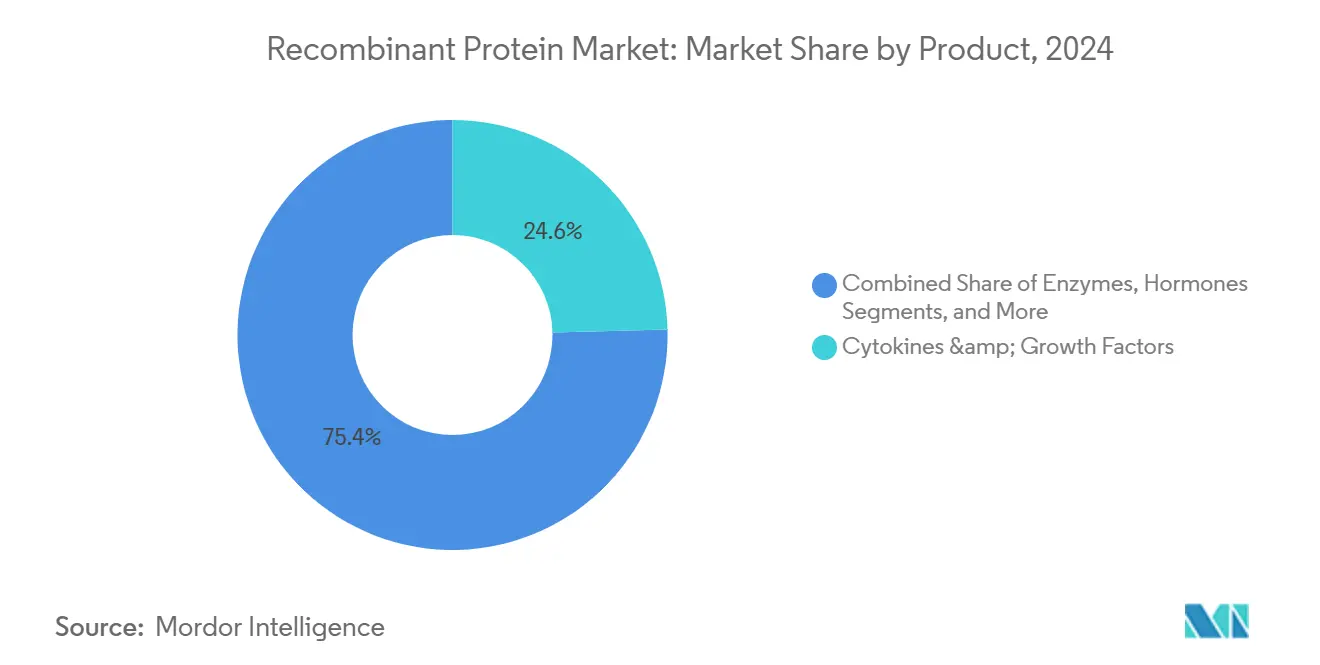
Note: Segment shares of all individual segments available upon report purchase
Expression System: Mammalian Dominance Challenged by Synthetic Alternatives
Mammalian platforms hold 45.15% Recombinant Proteins market share in 2024, driven by capacity to perform human-like post-translational modifications. Multiplex CRISPR editing is boosting viable cell density and extending fed-batch runs, an operational gain that lifts volumetric productivity [4]Ivan I. Vorobiev, “Genomic and Phenotypic Characterization of CHO 4BGD Cells with Quad Knockout and Overexpression of Two Housekeeping Genes That Allow for Metabolic Selection and Extended Fed-Batch Culturing,” Cells, mdpi.com. Genetic stabilization decreases batch-to-batch variability, a factor valued by regulators.
Cell-free and synthetic systems are clocking an 8.72% CAGR, offering days-long development cycles versus weeks for cell-based approaches. Demonstrations of 100 mg/L antibody titers in small-scale reactors validate industrial feasibility. Decoupling expression from cell viability enables toxic or unstable proteins to enter development pipelines previously deemed untenable.
Application: Therapeutic Uses Drive Market While Industrial Applications Surge
Therapeutic use represented 34.21 % of the Recombinant Proteins market size in 2024, underpinned by a steady cadence of FDA approvals for novel biologics. The green-light for a first-in-class autologous gene therapy targeting epidermolysis bullosa exemplifies how protein-based modalities are addressing unmet needs. Regulatory receptivity to complex platforms reinforces investor confidence.
Industrial applications are projected to grow at a 9.26% CAGR, propelled by precision fermentation that yields animal-free food proteins and eco-friendly enzymes for agriculture. Corporate sustainability mandates are increasingly incorporating biotech routes to mitigate carbon footprints. Industrial demand helps buffer revenue volatility associated with therapeutics.
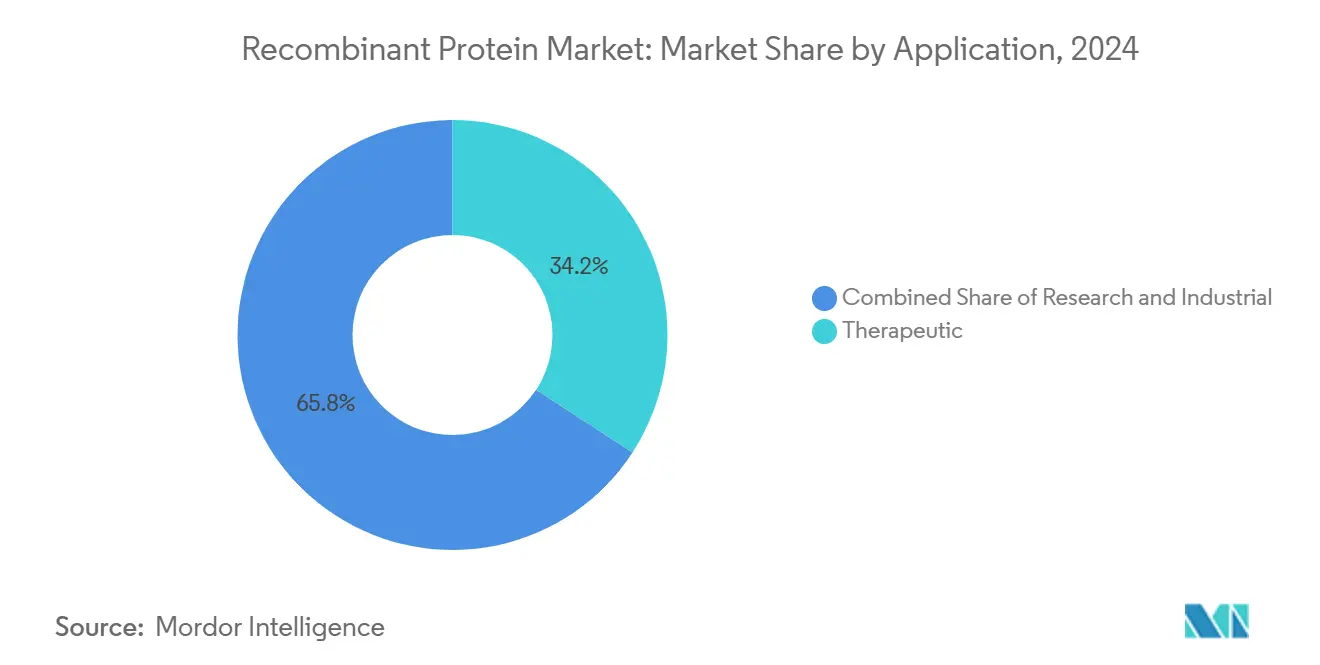
Note: Segment shares of all individual segments available upon report purchase
End User: Pharmaceutical Companies Lead While CROs & CDMOs Gain Traction
Pharmaceutical and biotechnology firms capture 38.19% of Recombinant Proteins market share, leveraging deep R&D budgets and legacy manufacturing networks. Capital expenditures such as a USD 900 million plant expansion signal an industry commitment to vertical integration. Onshoring initiatives also function as geopolitical risk hedges.
CROs and CDMOs are forecast to rise at an 8.51% CAGR through 2030 as outsourcing gains favor among asset-light biotech start-ups. Integrated CRDMO formats improve project continuity and accelerate tech transfer. Strategic collaborations are expected to increasingly adopt shared intellectual property structures to align incentives across development stages.
Geography Analysis
North America retained 41.13% Recombinant Proteins market share in 2024, driven by favorable reimbursement, venture capital availability, and a proactive regulatory stance. Federal funding for bio-industrial capacity upgrades further amplifies domestic production scaling. Regional cluster density accelerates labor specialization, increasing productivity per operator.
Europe remains the second-largest market, benefitting from cohesive academic-industry ecosystems and forward-leaning biosimilar guidelines. Anticipated easing of comparative trial requirements could lower development costs, making the region more attractive for small and midsized entrants. Regulatory harmonization across member states may compress launch timelines and level competition with North America.
Asia-Pacific is forecast to register a 9.51% CAGR from 2025 to 2030, reflecting aggressive national investment in biomanufacturing corridors and skilled workforce training programs. China's USD 4.17 billion commitment to expand capacity underscores the region's ambition to achieve self-reliance in biologics production. Early movers can capture contract manufacturing overflow from Western markets constrained by capacity bottlenecks, potentially reshaping global supply chain geography.
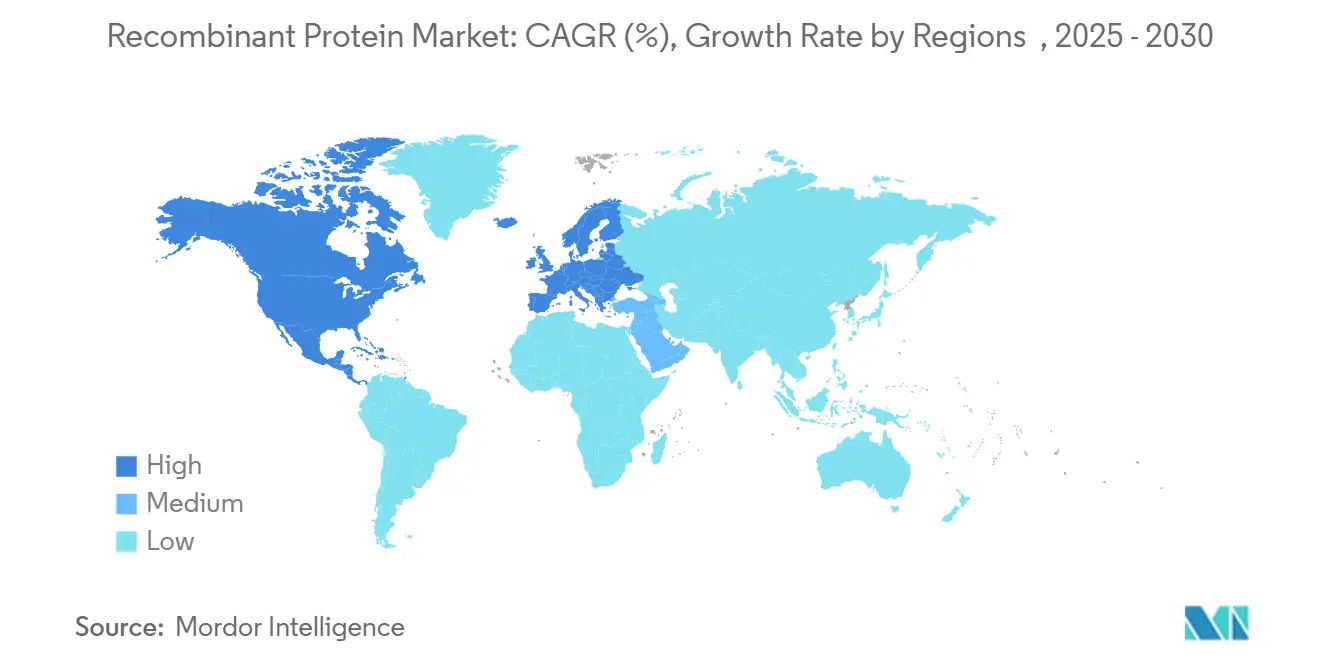
Competitive Landscape
The Recombinant Proteins industry is moderately fragmented, with established multinationals coexisting alongside niche specialists and contract manufacturers. Market leaders deploy economies of scale in both R&D and downstream logistics to defend share. Size alone is no longer sufficient, as agility in adopting new production technologies increasingly distinguishes front-runners.
Technological differentiation is intensifying. Proprietary microbial platforms such as EffiXTM claim higher volumetric yields and faster strain-engineering cycles, enhancing competitiveness for plasmid DNA and difficult-to-express proteins. Technology licensing could provide a revenue stream for platform owners seeking to monetize their know-how beyond in-house pipelines.
Artificial intelligence is fast becoming an axis of competition, with several companies advancing AI-generated protein candidates into clinical evaluation. Early evidence suggests these approaches can cut discovery timelines by nearly half, offering potential first-to-market advantages. Intellectual property frameworks will need to evolve to clarify ownership of machine-generated sequences.
Recombinant Protein Industry Leaders
-
Eli Lilly and Company
-
Thermo Fisher Scientific Inc.
-
Novartis AG
-
GlaxoSmithKline PLC
-
Pfizer Inc.
- *Disclaimer: Major Players sorted in no particular order
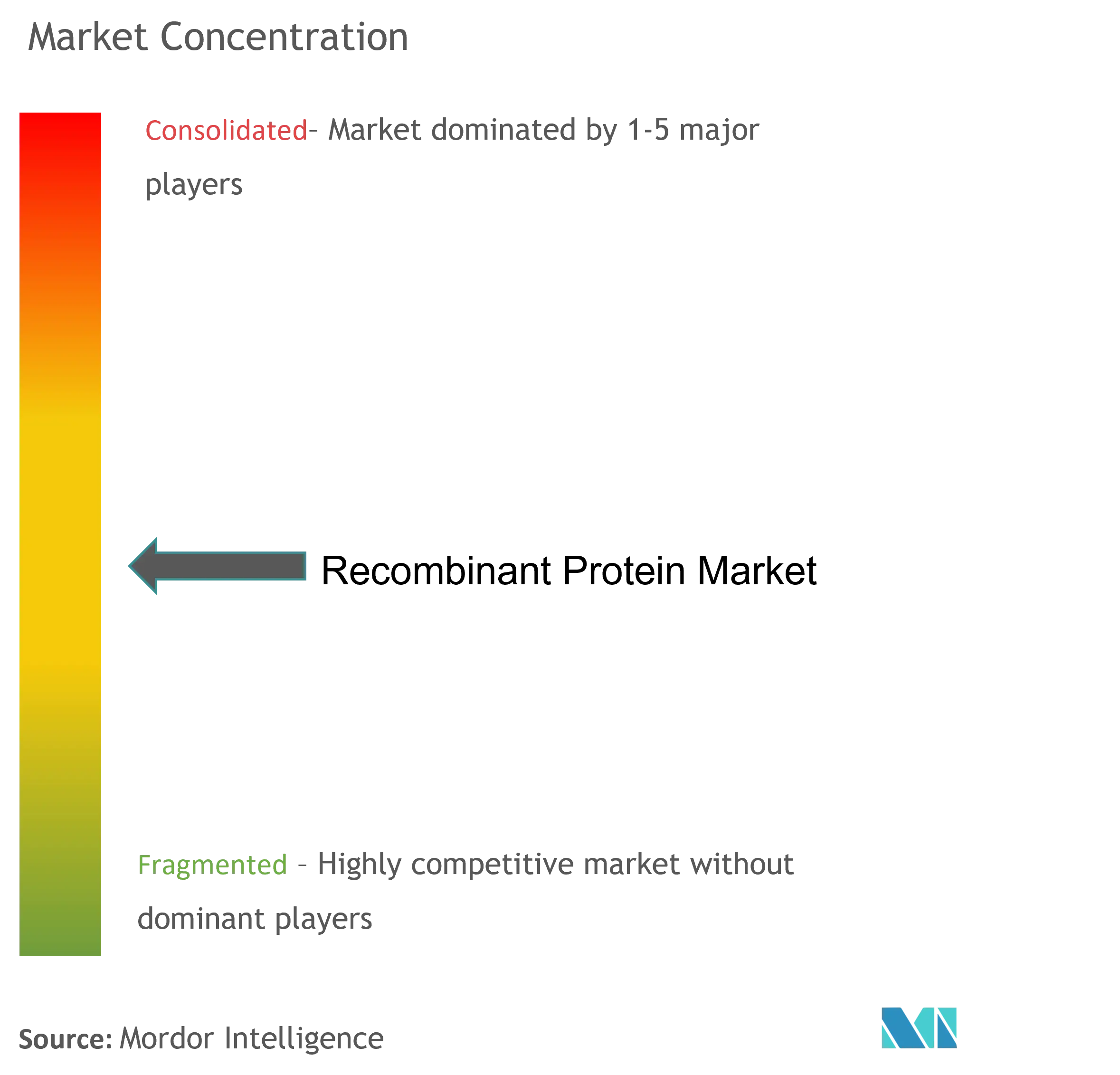
Recent Industry Developments
- April 2025: Amgen invested USD 900 million to expand its Ohio biomanufacturing facility, increasing domestic capacity for recombinant proteins and signaling confidence in U.S. onshoring.
- March 2025: WuXi Biologics introduced the EffiXTM microbial expression platform aimed at boosting recombinant protein and plasmid DNA yields, enhancing process economies.
- September 2024: ScaleReady and Bio-Techne launched ProPakTM GMP cytokines optimized for closed-system cell therapy manufacturing to improve consistency and scalability.
Research Methodology Framework and Report Scope
Market Definitions and Key Coverage
Our study defines the recombinant protein market as revenue earned from purified proteins produced through recombinant-DNA expression in mammalian, bacterial, yeast, insect, or cell-free systems and supplied for therapeutic use, pre-clinical or clinical research, and select bioprocess reagents. We count finished molecules such as insulin, cytokines, monoclonal fragments, enzymes, and fusion constructs at the ex-factory selling price.
Scope Exclusions: Diagnostic antibodies, bulk food enzymes, and contract manufacturing service fees are outside the scope.
Segmentation Overview
- By Product
- Hormones (Insulin, EPO, hGH, FSH)
- Cytokines & Growth Factors (ILs, CSFs, IFNs)
- Monoclonal Antibodies & Fragments
- Enzymes
- Fusion Proteins & Others
- By Expression System
- Mammalian (CHO & HEK293)
- Bacterial (E. coli)
- Yeast (Pichia, Saccharomyces)
- Insect (Sf9, Sf21)
- Cell-Free / Synthetic
- By Application
- Therapeutic
- Research
- Industrial (Agro-biotech, Food, Detergents)
- By End User
- Pharmaceutical & Biotechnology Companies
- Academic & Research Institutes
- CROs & CDMOs
- By Geography
- North America
- United States
- Canada
- Mexico
- Europe
- Germany
- United Kingdom
- France
- Italy
- Spain
- Rest of Europe
- Asia-Pacific
- China
- Japan
- India
- South Korea
- Australia
- Rest of Asia-Pacific
- Middle East
- GCC
- South Africa
- Rest of Middle East
- South America
- Brazil
- Argentina
- Rest of South America
- North America
Detailed Research Methodology and Data Validation
Primary Research
Mordor analysts interviewed bioprocess engineers at contract development organizations, academic group leaders, and hospital formulary managers across North America, Europe, and Asia. Their insight on batch yields, price corridors, and near-term capacity plans let us recalibrate desk findings and validate hidden assumptions.
Desk Research
We began by mapping demand with open datasets from the US FDA biologic approvals, EMA Community Register filings, NIH RePORTER grant counts, and OECD health-R&D trends. Trade codes in UN Comtrade and national customs portals helped size cross-border flows of insulin, interferons, and growth factors. PubMed articles and Questel patent families revealed pipeline depth, while 10-Ks, investor decks, and pricing drawn from D&B Hoovers and Dow Jones Factiva showed average selling prices and shipment ranges. These sources illustrate, not exhaust, the backbone we used.
A second sweep checked regional health budgets, clinical-trial registries, and association white papers to align prevalence data with reagent consumption. Together, these strands formed a coherent historic baseline before any forecasts were run.
Market-Sizing & Forecasting
We rebuild the market with a top-down demand pool that links treated patient cohorts, reagent-consumption norms, and industrial usage, which is then filtered through price bands by protein class. Select bottom-up supplier roll-ups and channel checks confirm totals. Key variables include new therapeutic approvals, oncology and diabetes prevalence, mammalian bioreactor capacity, proteomics grant spend, and post-patent price erosion. A multivariate regression engine projects every driver, and scenario analysis layers in regulatory or manufacturing shocks.
Data Validation & Update Cycle
Outputs pass multi-step peer review. Analysts compare modeled totals with shipment disclosures, customs anomalies, and spot price trackers, re-contacting sources when variances exceed thresholds. We refresh figures each year and issue interim flashes when material events occur.
Why Mordor's Recombinant Protein Baseline Deserves Decision-Maker Confidence
Estimates often diverge because firms choose different product baskets, currencies, or refresh cadences.
According to Mordor Intelligence, the 2025 global market equals USD 2.9 billion, offering a grounded midpoint for planning.
Benchmark comparison
| Market Size | Anonymized source | Primary gap driver |
|---|---|---|
| USD 2.9 B (2025) | Mordor Intelligence | - |
| USD 3.01 B (2024) | Global Consultancy A | Narrower product list, desk-only validation |
| USD 2.2 B (2023) | Industry Association B | Excludes research reagents, older currency base |
| USD 3.52 B (2024) | Regional Consultancy C | Adds diagnostic antibodies, optimistic pricing |
Differences stem mainly from scope drift and limited field checks. By combining clearly defined coverage with on-ground validation, we supply a balanced, transparent baseline that clients can reproduce and trust.
Key Questions Answered in the Report
How big is the Recombinant Protein Market?
The Recombinant Protein Market size is expected to reach USD 2.90 billion in 2025 and grow at a CAGR of 7.91% to reach USD 4.25 billion by 2030.
Which product segment holds the largest Recombinant Proteins market share?
Cytokines and growth factors lead with roughly one-quarter of total revenue due to broad use in immunotherapy and regenerative medicine.
Who are the key players in Recombinant Protein Market?
Eli Lilly and Company, Thermo Fisher Scientific Inc., Novartis AG, GlaxoSmithKline PLC and Pfizer Inc. are the major companies operating in the Recombinant Protein Market.
Which is the fastest growing region in Recombinant Protein Market?
Asia-Pacific is estimated to grow at the highest CAGR over the forecast period (2025-2030).
Which region has the biggest share in Recombinant Protein Market?
In 2025, the North America accounts for the largest market share in Recombinant Protein Market.
Why are cell-free expression systems gaining attention?
They shorten development cycles, allow production of toxic or unstable proteins, and can reduce manufacturing costs by eliminating cell culture steps.
Page last updated on:
